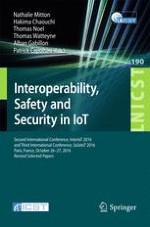2017 | Buch
Interoperability, Safety and Security in IoT
Second International Conference, InterIoT 2016 and Third International Conference, SaSeIoT 2016, Paris, France, October 26-27, 2016, Revised Selected Papers
herausgegeben von: Nathalie Mitton, Hakima Chaouchi, Thomas Noel, Thomas Watteyne, Alban Gabillon, Patrick Capolsini
Verlag: Springer International Publishing
Buchreihe : Lecture Notes of the Institute for Computer Sciences, Social Informatics and Telecommunications Engineering
